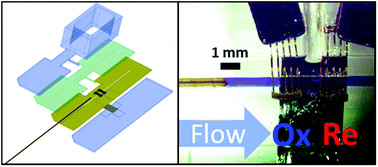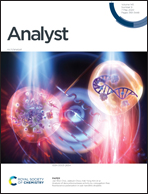Direct embedding and versatile placement of electrodes in 3D printed microfluidic-devices†
Abstract
In this paper, we describe how PolyJet 3D printing technology can be used to fully integrate electrode materials into microfluidic devices during the print process. This approach uses stacked printing (separate printing steps and stage drops) with liquid support to result in devices where electrodes and a capillary fluidic connection are directly integrated and ready to use when printing is complete. A key feature of this approach is the ability to directly incorporate electrode materials into the print process so that the electrode(s) can be placed anywhere in the channel (at any height). We show that this can be done with a single electrode or an electrode array (which led to increases in signal). In both cases, we found that a middle electrode configuration leads to a significant increase in the sensitivity, as opposed to more traditional bottom channel placement. Since the electrode is embedded in the device, in situ platinum black deposition was performed to aid in the detection of nitric oxide. Finally, a generator-collector configuration with an opposed counter electrode was made by placing two working electrodes ∼750 μm apart (in the middle of the channel) and a platinum counter electrode at the bottom of the channel. The utility of this configuration was demonstrated by dual electrode detection of catechol. This 3D printing approach affords robust electrochemical detection schemes with new electrode configurations being possible in a manner that also increases the ease of use and transferability of the 3D printed devices with integrated electrode materials.



 Please wait while we load your content...
Please wait while we load your content...